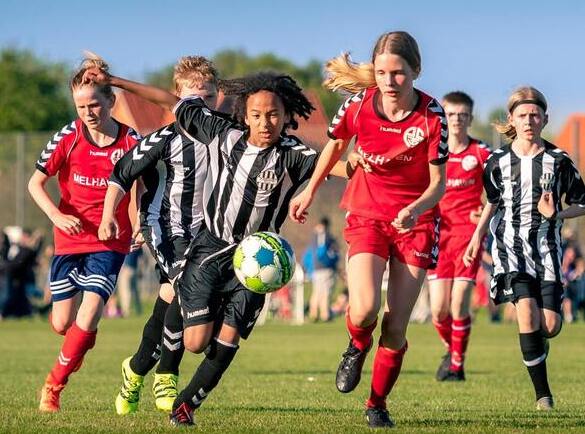6.2: Physical Development During Middle Childhood
- Last updated
-
-
Save as PDF
Middle childhood (also referred to as middle and late childhood) is the period of life that begins when children enter school (somewhere around age 6-12) and lasts until they reach adolescence. Early childhood and adolescence seem to get much more attention than middle childhood. Perhaps this is because growth patterns slow a bit at this time, the selfish "id" becomes hidden during the latent stage, according to Freud, and the majority of children (in the United States) tend to spend much more time in school, with friends, and in structured activities. It may be easy for parents and caregivers to lose track of their children’s development unless they stay directly involved in their day-to-day world and interests. It is also important for parents and caregivers to pause in their own busy lives and give full attention to middle childhood to stay in touch with these children and to take notice of the varied influences on their lives in a larger world.
Growth Rates and Motor Skills
Middle childhood has been called the “golden age” of childhood. Overall, children are relatively healthy during this period. Growth rates slow and children start gaining about 5-7 pounds in weight and 2 inches in height each year. Many children begin to slim down as their torsos become longer. A child at this age can have strong muscles and increased lung capacity to enable them to play for long periods of time. The brain reaches its adult size at about age 7. The school-aged child can is better able to plan, coordinate activity using both left and right hemispheres of the brain, and to control emotional outbursts. Paying attention is also improved as the prefrontal cortex matures. And, as the myelin continues to develop (myelin speeds the conduction of nerve impulses, among many other benefits), the child’s reaction time and motor abilities also improve. Children of this age tend to sharpen their abilities to perform both gross motor skills, such as riding a bike, and fine motor skills, such as cutting their fingernails.
Organized Sports: Pros and Cons
Middle childhood seems to be a great time to introduce children to organized sports. And, in fact, many parents and caregivers do. Sports activity has been reported to help children build social skills, improve athletically and learn a sense of teamwork. It has been suggested, however, that the emphasis on competition and athletic skill can be counterproductive and lead children to grow tired of the game and want to quit. In many respects, it appears that children’s activities are no longer children’s activities once adults become overly-involved and approach the games as adults rather than children. The U. S. Soccer Federation recently advised coaches to reduce the amount of drilling engaged in during practice and to allow children to play more freely and to choose their own positions. The hope is that this will build on their love of the game and foster their natural talents (Player Development Initiatives, October, 2017).
Death and Overall Health in Middle Childhood
While children in the United States are most likely to die due to accidents, this may not be the case in many other countries. Tragically, children still die due to malnutrition and diseases. The good news is that these preventable deaths have declined considerably since 1990. At the same time, however, deaths due to accidents have only declined slightly.
5-14 years of age
- Accidents (unintentional injuries)
- Cancer
- Intentional self-harm (suicide)
The information provided above was obtained from the CDC (Centers for Disease Control and Prevention). The leading causes of death in 2017 are the same as they were in 2013.
Childhood Obesity
While the topic of obesity is a complex one, over the past four decades, we have witnessed childhood obesity grow to epidemic proportions. As of 2019, more than 13 million children and adolescents are obese or overweight. That’s roughly one child in every three (U. S. Department of Health and Human Services, 2017, HHS.gov). This is defined as being at least 20 percent over their ideal weight. The prevalence of obesity and severe obesity increases with age. While percentages vary by region, in 2015-2016, the rates of obesity in the United States was 18.4% for children ages 6 to 11 (stateofobesity.org/childhood-obesity-trends).
Prevalence of Childhood Obesity in the United States (CDC, 2019)
Childhood obesity is a serious problem in the United States putting children and adolescents at risk for poor health. Obesity prevalence among children and adolescents is still too high.
For children and adolescents aged 2-19 years1:
- The prevalence of obesity was 18.5% and affected about 13.7 million children and adolescents.
- Obesity prevalence was 13.9% among 2- to 5-year-olds, 18.4% among 6- to 11-year-olds, and 20.6% among 12- to 19-year-olds. Childhood obesity is also more common among certain populations.
- Hispanics (25.8%) and non-Hispanic blacks (22.0%) had higher obesity prevalence than non-Hispanic whites (14.1%).
- Non-Hispanic Asians (11.0%) had lower obesity prevalence than non-Hispanic blacks and Hispanics.
1Read CDC National Center for Health Statistics (NCHS) data brief pdf icon[PDF-603KB]
Note: Obesity is defined as a body mass index (BMI) at or above the 95th percentile of the CDC sex-specific BMI-for-age growth charts.
Obesity and Socioeconomic Status (CDC, 2019)
[Read the Morbidity and Mortality Weekly Report (MMWR)]
- The prevalence of obesity decreased with increasing level of education of the household head among children and adolescents aged 2-19 years.
- Obesity prevalence was 18.9% among children and adolescents aged 2-19 years in the lowest income group, 19.9% among those in the middle income group, and 10.9% among those in the highest income group.
- Obesity prevalence was lower in the highest income group among non-Hispanic Asian and Hispanic boys.
- Obesity prevalence was lower in the highest income group among non-Hispanic white, non-Hispanic Asian, and Hispanic girls. Obesity prevalence did not differ by income among non-Hispanic black girls.
Some Reasons
This is true in part because of the introduction of a steady diet of television, computer and smart phone screen time increase and other sedentary activities. In addition, we have come to emphasize high fat, fast foods as a culture. Processed pizza, hamburgers, chicken nuggets and “lunchables” with soda have replaced more nutritious foods as staples.
Some Consequences
Children who are overweight tend to be ridiculed and teased by others. This can certainly be damaging to their self-image and sense of value. In addition, obese children run the risk of struggling with orthopedic problems such as knee injuries, and an increase risk of heart disease and stroke in adulthood. It can be difficult for a child who is obese to become a non-obese adult. In addition, the number of cases of pediatric diabetes has risen dramatically in recent years and weight can be correlated with that in some individuals.
Some Recommendations
Dieting is not really the answer. If you diet, your basal metabolic rate tends to decrease thereby making the body burn even fewer calories in order to maintain the weight. Eating less processed foods and consuming whole foods is generally a better option than dieting (think in terms of fresh food you prepare vs. highly processed foods that come out of a box as a guideline). Increased activity is also much more effective than dieting in improving the child’s (and adult's, too) health and psychological well-being. Physical movement reduces stress, releases "feel-good" neurochemicals and being an overweight child, subjected to the ridicule of others can certainly be stressful. Parents and caregivers could take caution against emphasizing diet alone to avoid the development of any obsession about dieting that can lead to eating disorders as teens. Again, increasing a child’s activity level is usually most helpful as is a whole-person perspective, meaning taking into account a person's own ability levels, food allergies and so on.

Figure 6.2.2: The key to a healthy weight is healthy choices (Unsplash license; Sarah Gualtieri via Unsplash)
A Look at School Lunches
On paper, the National School Lunch Program is great. It is designed to provide kids with low-cost, nutritionally balanced meals that are based on constantly updated guidelines from the USDA. The purpose of the NSLP is to get food to kids of every social status with minimal issues. Of course, when the lunches finally end up in front of the kids, they look very different from what other kids are eating across the world. (Andress, J. 2017). Many children in the United States buy their lunches in the school cafeteria, so it might be worthwhile to look at the nutritional content of school lunches. You can obtain this information through your local school district’s website. An example of a school menu and nutritional analysis from a school district in north central Texas is a meal consisting of white flour pasta alfredo (cream based sauce), processed, white flour bread stick, peach cup (rather than a fresh, whole peach), tomato soup, a highly processed brownie, and 2% pasteurized milk and is considered in compliance with Federal Nutritional Guidelines of 108% calories, 24 % protein, 55 % carbohydrates, 27% fat, and 8% saturated fats, according to the website. Students may also purchase chips, cookies, or ice cream along with their meals. Many school districts rely on the sale of desert and other items in the lunchrooms to make additional revenues. Many children purchase these additional items and so our look at their nutritional intake should also take this into consideration.

Figure 6.2.3: A typical school lunch in America might consist of highly processed food such as a hot dog on a white flour bun with french fries and no other vegetables. (Unsplash license; Wade Austin Ellis via Unsplash)
Now...Consider another menu from an elementary school in the state of Washington. This sample meal consists of a chicken burger, baked tater tots, fruit and veggies and milk. This meal is also in compliance with Federal Nutrition Guidelines but has about 300 fewer calories. And, children are not allowed to purchase additional deserts such as cookies or ice cream.
Of course, children eat away from school as well. Listen to NPR’s Kids Have Easy Access to Junk Food to hear a story about how advertising and fast food restaurant locations may influence children’s diets.




